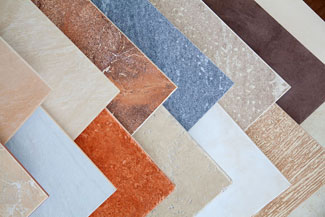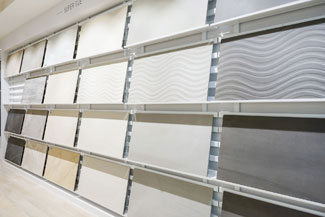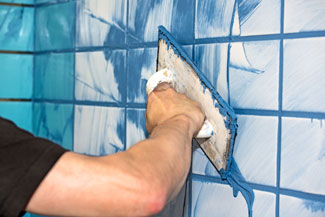Tile Styles
THE WORLD OF CERAMIC TILE IS WIDE AND SPECTACULAR.
Ceramic tile offers a broad range of textures, patterns, and sizes. When combined with a spectrum of grout and glaze options, they offer significant design variation for any room in virtually any home style.
THE BASIC THREE.
There are three types of ceramic tile: glazed, unglazed, and porcelain. Glazed ceramic tiles are coated with glass-forming minerals and ceramic stains. Typically, they have a matte, semi-gloss, or high-gloss finish. They can offer better stain and moisture resistance than unglazed tile. Glazed tiles can also have different finishes and you should be aware of them for future considerations. High gloss finishes can be slippery, and scratches can become more visible, while matte or textured finishes help with traction and scratches, and dirt is less visible.
Unglazed ceramic tiles are very hard and dense. They come in various surface treatments and textures. Typically, these are installed outside your home as they do not offer much protection against stains compared to glazed ceramic tile. Unglazed tiles do have good slip resistance, however, please note that they do require sealing to help prevent staining.
Porcelain tiles usually fall in the ceramic tile category and are the hardest and densest tiles available. Porcelain is made up of 50% feldspar and is fired at a much higher temperature than regular ceramic tile. Because the color in porcelain tile goes all the way through, they are non-porous, resist scratching, and can withstand temperature extremes.
SIZE AND SELECTION ABOUND.
Ceramic tile is manufactured in sizes ranging from 1” to 24” squares. Ceramic tile is normally boxed and priced by the square foot, regardless of the size of the individual tile itself. Tile size is relative and is usually referred to by its nominal size, not its actual size. During the firing process, ceramic tile will shrink by about 10%. When considering what size tile would be appropriate for your given space, start by determining the size of the room. Scale plays as important role in creating a room’s overall balance.
Ceramic and porcelain manufacturers have created tiles that offer textures, colors, and patterns resembling natural stone products. To further enhance a natural look, tile can also be made to feature heavy textures, chiseled and hammered edges, and even resemble wood.
FEEL FREE TO CUSTOMIZE.
In addition to ceramic tile styles, manufacturers also offer decorative inserts, medallions, and mosaics that are used to create intricate patterns and beautiful borders. Tile sizes 2” x 2” and smaller are usually referred to as mosaics and are often used with different colors to create patterns or to create a decorative inset. Patterned borders made up of different sized tiles or colors can create beautiful looks. Simple variations in color, shape, or size can be patterned within a room or across several adjoining rooms. Let your imagination run free and ceramic will keep up with it.
UNDERSTAND YOUR GROUT OPTIONS.
Grout is a type of cement that is used to fill the space and provide support in tile joints. There are two types of grout commonly used in home installations: Portland cement based and epoxy based. Both grout compounds may have sand added to provide additional strength to the tile joint. Grout can be pigmented to give a nearly infinite range of colors. Pigment is added to the cement at the job site when the grout is mixed. Grout color and thickness will change the appearance of the floor and room dramatically. Using a white or light-colored grout highlights the color in the tile. Choosing a dark grout with a light tile, or a light grout with a dark tile will emphasize the geometric pattern of your layout.
NOT ALL CERAMIC TILE IS SUITABLE FOR EACH AREA OF YOUR HOME.
The beautiful decorative tile you might put on your kitchen backsplash may not be recommended for installation on your floor. Most manufacturers have a rating system that is based on the American Society for Testing and Materials (ASTM). The most common system rates ceramic tile abrasion resistance, or the overall durability of the tile. There are five classes of tile durability.
Class 1: No foot traffic. These tiles are suggested for interior wall applications and not for the floor.
Class 2: Light traffic. These tiles are suggested for interior wall applications and for residential bathroom flooring only.
Class 3: Light to moderate traffic. These tiles can be used for residential floor and wall applications including bathrooms, kitchens, foyers, dining rooms, and family rooms. They are a good all-around performer.
Class 4: Moderate to heavy traffic. These tiles are recommended for residential, medium commercial, and light industrial floor and wall applications, including shopping malls, offices, restaurant dining rooms, showrooms, and hallways.
Class 5: Heavy to extra heavy traffic. These tiles can be installed anywhere. They will hold up in floor and wall applications in high traffic areas such as airports, supermarkets, and subways.
You may also see a rating for slip resistance, which is measures by its Coefficient of Friction (COF). The higher the COF, the more slip resistance the tile. This is important when selecting a floor tile for areas that get wet, such as your shower or bathroom floor.
Other ratings listed by the manufacturer might include scratch resistance, moisture absorption, chemical resistance, and breaking strength.





